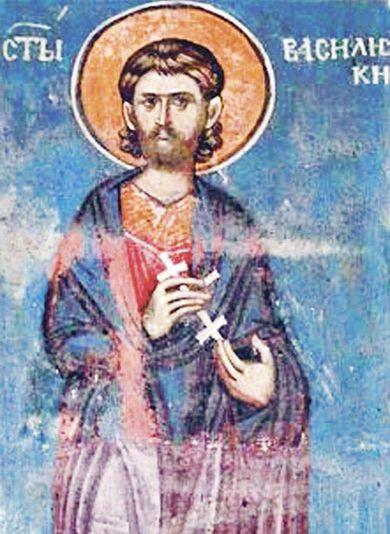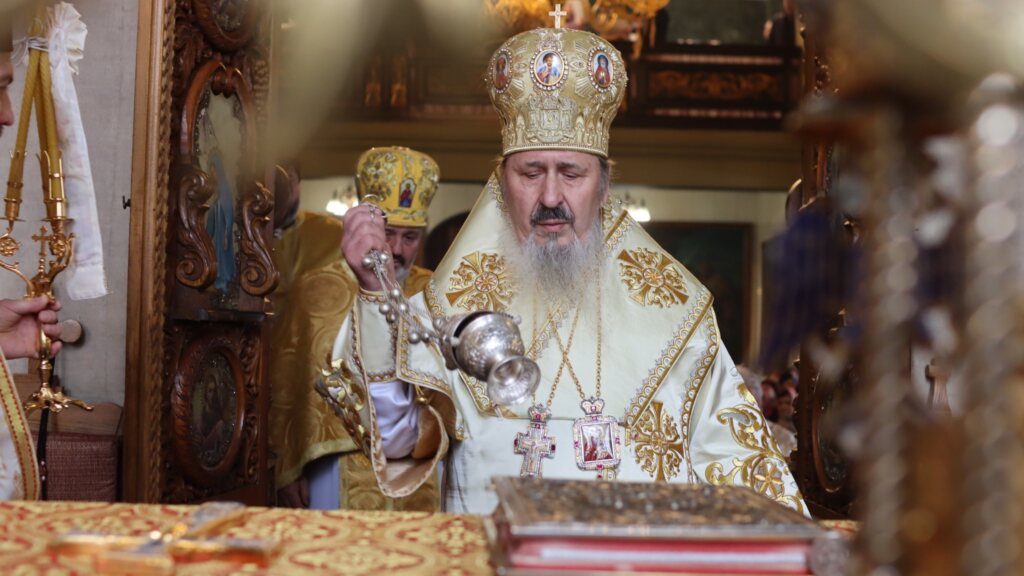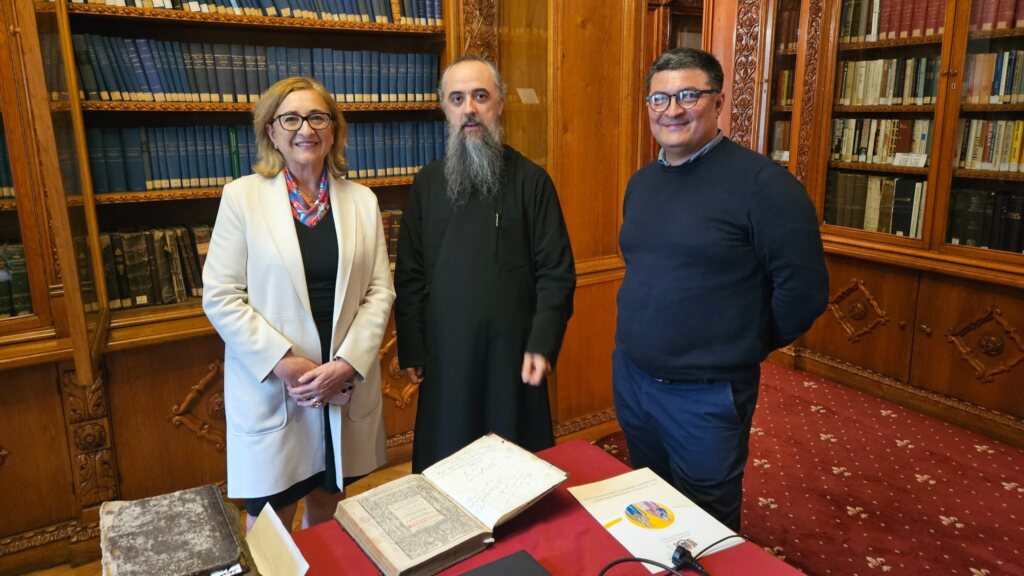Holy Martyr Basiliscus
He was a nephew of the Great Martyr Theodore the Recruit (February 17), and he suffered together with his brothers Eutropius and Kleonikos during the persecution of the emperor Maximian Galerius (305-311).
The holy martyrs Kleonikos and Eutropius (March 3) were crucified, but the martyr Basiliscus was sent to Comana where he was detained in prison.
The governor Agrippa arrived in the city of Amasea, and started a persecution against Christians. Saint Basiliscus in prison prepared himself for his impending ordeal. The Lord appeared to him in a dream, promising the martyr His help, and foretold his martyric death at Comana. Saint Basiliscus asked the prison guards to let him go to his native village to bid his relatives farewell.
They let him go, since they respected him for his holy life and working of miracles. Arriving home, Saint Basiliscus saw his family one last time, and urged them to stand firmly in the Faith.
When Agrippa learned that Saint Basiliscus had gone to see his relatives, he went into a rage. He chastized the prison guards, and he sent a detachment of soldiers after the martyr, headed by a cruel magistrianum (adjutant of the governor). Meeting Saint Basiliscus, who was actually on his way back, the magistrianum placed heavy chains on him, and shod him with metal sandals with nails driven into the soles, and set off to Comana.
Arriving at a certain village during the hot afternoon, the travellers stayed at the house of a woman named Troana. The soldiers went into the house to relax and refresh themselves with food, and they tied the martyr Basiliscus to a dry tree. Standing in the heavy chains beneath the scorching sun, the saint prayed to God. Suddenly a Voice was heard from above, “Fear not, for I am with you.”
The earth shook, and a spring of water came forth from the fissure. The magistrianum, the soldiers and Troana, rushed out of the house, frightened by the earthquake. Shaken by the miracle which had taken place, they set the martyr free. Sick people from the village came to the holy martyr and received healing through his prayers.
When the saint finally stood before Agrippa, he was commanded to offer sacrifice to the pagan gods. He replied, “I offer to God a sacrifice of praise and thanksgiving every hour.” They led him into a pagan temple. In an instant fire came down from Heaven, which burned the temple, and reduced the idols to dust. Then in a blind rage Agrippa gave orders to behead Saint Basiliscus and throw his body into the river. The death of the martyr occurred in the year 308.
Christians quickly gathered the remains of the holy martyr, and buried them by night in a ploughed field. Upon this spot a church was built in honor of Saint Basiliscus, into which they transferred his relics. Through the prayers of the holy martyr healings began to occur. The saint appeared in a dream to Saint John Chrysostom (November 13) before his death at Comana and said to him, “Tomorrow we shall be together.” Saint Eusignius (August 5) was an eyewitness to his sufferings and told the world about the struggles of Saint Basiliscus.
Troparion — Tone 4
Your holy martyr Basiliscus, O Lord, / through his suffering has received an incorruptible crown from You, our God. / For having Your strength, he laid low his adversaries, / and shattered the powerless boldness of demons. / Through his intercessions, save our souls!
The Second Ecumenical Council
It was convened in the year 381 and consolidated the victory of Orthodoxy attained in the year 325 at the First Ecumenical Council.
During the difficult years which passed after the acceptance of the Nicene Symbol of Faith (Creed), the Arian heresy developed new offshoots. Under the guise of struggle against the Sabellian heresy, which taught about a blending of the Hypostatic Persons of the Father and the Son [as mere aspects or modalities within the Trinity], Macedonius began to employ the word “homoiousios” “of similar essence” [in contrast to the Orthodox teaching of “homoousios”, “of the same essence”] regarding the essence of the Son and that of the Father.
This formula still presented a danger because Macedonius presented himself as a struggler against the Arians, who used the term “like the Father.” Besides this, the Macedonians, being semi-Arians, depending on conditions and advantages of the moment, sometimes inclined towards Orthodoxy, sometimes towards Arianism. They blasphemed the Holy Spirit by suggesting that He was not “of the same essence” with the Father and the Son.
A second heretic, Aetius, introduced the concept “anomoion” (“different in essence.” He said that the Father has a completely different essence from that of the Son. His disciple Eunomios taught a hierarchical subordination of the Son to the Father, and of the Holy Spirit to the Son.
Everyone who came to him was rebaptized into the “death of Christ,” denying Baptism in the Name of the Father and of the Son and of the Holy Spirit, which is commanded us by the Savior Himself (Mt. 28:19).
A third heresy arose from the teachings of Valentius and Ursacius at the Arimonian Council. They attempted to deceive the Orthodox bishops, proclaiming that the Son of God is from God, and is in the likeness of God the Father, and is not a created being as the Arians taught.
The heretics did not wish to use the term “one in essence” in describing the relation of the Son to the Father, saying that the word “essence” is not found within the Holy Scripture. Besides these three main heresies, there were also many other false teachings.
The heretic Apollinarios said, “The flesh of the Savior did not have a human soul or reason. The Word of God took the place of the absent soul; and Divinity remained dead for three days.”
For dealing with these crafters of heresy, the holy Emperor Theodosius the Great (379-395) convened an Ecumenical Council at Constantinople, at which 150 bishops were present. Upon investigation by the holy Fathers it was proposed to affirm a Confession of Faith from a Roman Council, which holy Pope Damasus had sent to Bishop Paulinos of Antioch.
After reading the document aloud, the holy Fathers rejected the false teaching of Macedonius, and unanimously affirmed the Apostolic teaching that the Holy Spirit is not a subordinate being, but is rather the Life-Creating Lord, Who proceeds from the Father, and is worshipped and glorified with the Father and the Son. In order to combat other heresies, of the Eunomians, Arians and Semi-Arians, the holy Fathers affirmed the Nicene Symbol of the Orthodox Faith.
In the Symbol (Creed), accepted by the First Ecumenical Council, the divine nature of the Holy Spirit was not addressed, since at that earlier time [in 325] heresies against the Holy Spirit had not become widespread.
Therefore, the holy Fathers of the Second Ecumenical Council added to the Nicean Symbol its eighth, ninth, tenth, eleventh and twelfth sections. They definitively formulated and affirmed the Nicene-Constantinople Symbol of Faith, which is used even now by all the Orthodox Churches.
The Second Ecumenical Council also established the norms for ecclesiastical courts [Canon VI], and it decided to receive those repentant heretics who were properly baptized in the name of the Holy Trinity through Chrismation, but those baptized with a single immersion were to be received as pagans.
Tr by oca.org







